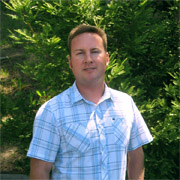TEAM MENU

EDUCATION
▫ University of California, Santa Cruz, B.S., Earth Science.
Graduated with highest honors in the major, college honors, and honors in undergraduate thesis work.
CONTINUING EDUCATION / TRAINING
▫ OSHA 1910.120: Hazardous Waste Operations and Emergency Response
REGISTRATION
▫ Registered Professional Geologist, State of California License No. 8452
REPRESENTATIVE EXPERIENCE
As a Project Geologist for Weber, Hayes and Associates, Mr. Chaney leads the management and field activities for conducting a wide range of environmental investigations and remediation including the supervision of UST closures, remedial excavations, completing soil and groundwater contaminant delineation investigations, soil vapor intrusion assessments, management of groundwater monitoring programs, and hazardous materials facility closures. Mr. Chaney is in charge of all aspects of project management, investigation work scope development, regulatory correspondence, and technical report writing documenting and interpreting data collected during all phases of environmental investigations.
Mr. Chaney is also in charge of conducting hydrogeologic testing and analysis for determining aquifer characteristics through performing and evaluating data collected during both large and small scale aquifer pumping tests and slug tests. Mr. Chaney has conducted numerous aquifer tests in and around the Monterey Bay area.
SELECTED PROJECTS
Gilroy, CA – Developed subsurface investigation program to determine the downgradient extent of MTBE contamination in multiple water bearing zones:
Fieldwork included directing the installation of and logging multiple continuously cored soil boring transects perpendicular to the calculated groundwater flow direction to verify off-site lithologic continuity as well as target depth discrete zones for groundwater sampling. Cone Penetrometer Testing (CPT) was also employed during this investigation to obtain real-time aquitard identification and in-situ sampling of potentially impacted groundwater-bearing zones. Evaluation of transect delineation investigation analytical results coupled with an in-depth understanding of the subsurface geology allowed for the determination of optimum downgradient monitoring well placement and design. Data collected during this investigation phase led to successful MTBE plume delineation and subsequent cleanup design.
Santa Cruz, CA – Constant rate pumping and aquifer recovery test of Karst aquifer:
Conducted a 72-hour constant rate well pumping and aquifer recovery test in a Karst aquifer setting utilizing electronic pressure transducers for high quality data collection in the pumping well and multiple observation wells during the test. The drawdown and aquifer recovery data from the pumping well and observation wells were used to successfully calculate localized aquifer characteristics and estimate long term pumping drawdown for the supply well. Daily flow measurements of multiple springs or spring-fed pond locations previously identified to be in direct connection with the pumping wells’ position in the Karst groundwater system were collected before, during and after the 3 days of pumping in order to determine potential negative impacts on flow from aquifer pumping. The well pumping and aquifer recovery test demonstrated that significant groundwater extraction could be accomplished far beyond the wells present capacity.
Felton, CA – On and Off-Site Subsurface Delineation Investigation of Historic PCE Release to Soil and Groundwater at Former Dry Cleaner Facility in a Shallow Bedrock Setting:
Developed and executed a soil and groundwater sampling program through the strategic placement of soil borings, groundwater monitoring wells, and soil vapor probes in order to fully define subsurface contaminant impacts related to a historic release of dry cleaning solvents to the subsurface. Investigative tasks also included: 1) interpretation of the localized shallow bedrock structure beneath the site including modeling of bedrock topography and its relationship to nearby, localized river bank spring outcrop locations to determine preferential groundwater contaminant flow paths, and 2) the completion of a 1-mile radius sensitive receptor survey to evaluate potential impacts to local water supply based on calculated groundwater gradient and flow direction, subsurface geology, and water well proximity to the site. Evaluation of comprehensive sample analytical data set and subsurface conditions demonstrated a successful delineation of contamination in soil and groundwater on and off-site leading to the development of cost effective corrective actions.
Santa Cruz, CA – Expedited Soil and Groundwater Delineation and Remediation for a Historic Fuel Release Unexpectedly Discovered During Property Development:
Petroleum hydrocarbon impacted soils were unexpectedly discovered during the initial phases of commercial property development significantly impacting construction activities and project funding. A review of historical documents (i.e., Sanborn Insurance Maps coupled with reverse telephone directory records and historical aerial photographs) indicated that a gas station operated at this corner of the property through the 1930’s into the mid-1940’s and was the likely source of the soil contamination. An expedited remedial excavation effort coordinated with Santa Cruz County Environmental Health Services Agency was completed the very next day removing approximately 200 yards of impacted soils. Subsequently we obtained expedited regulatory approval for, and completed: 1) a search for potential abandoned underground fuel tanks, 2) a soil and groundwater delineation investigation, and 3) the removal and proper disposal of an additional 350 yards of impacted soil. The completion of these activities lead to the successful closure of this fuel release investigation within two months of initial discovery and property development was able to continue relatively unhindered.
Los Gatos, CA – Hazardous Materials Facility Closure and Remediation for Residential Land Use Transition:
Coordinated and permitted hazardous materials facility closure activities with the Santa Clara County Fire Department to successfully close a former automotive dealership and service center that was being transitioned for residential land use. Facility closure activities included: 1) permitted closure and removal of gasoline and waste oil underground storage tanks (USTs), and underground hydraulic oil reservoirs, and 2) confirmation soil sampling beneath the removed USTs and hydraulic oil reservoirs, and beneath numerous removed hydraulic hoists and feed lines, waste water discharge lines, clarifiers, and sumps. Remedial excavation and proper disposal of elevated concentrations of contaminants discovered in tested soils beneath some of the facility infrastructure was coordinated with the Santa Clara County Department of Environmental Health (SCCDEH). Successful soils remediation lead to SCCDEH case closure and unrestricted land use for residential development.
PROFESSIONAL AFFILIATIONS
▫ Groundwater Resources Association
▫ Davenport Geological Society

